
Question Number 16302 by mrW1 last updated on 20/Jun/17
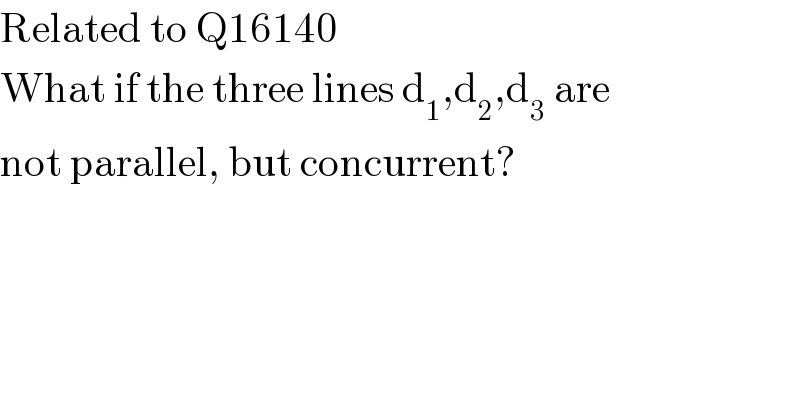
$$\mathrm{Related}\:\mathrm{to}\:\mathrm{Q16140} \\ $$$$\mathrm{What}\:\mathrm{if}\:\mathrm{the}\:\mathrm{three}\:\mathrm{lines}\:\mathrm{d}_{\mathrm{1}} ,\mathrm{d}_{\mathrm{2}} ,\mathrm{d}_{\mathrm{3}} \:\mathrm{are} \\ $$$$\mathrm{not}\:\mathrm{parallel},\:\mathrm{but}\:\mathrm{concurrent}? \\ $$
Commented by b.e.h.i.8.3.4.1.7@gmail.com last updated on 20/Jun/17

$${where}\:{is}\:'{b}'? \\ $$
Commented by mrW1 last updated on 20/Jun/17
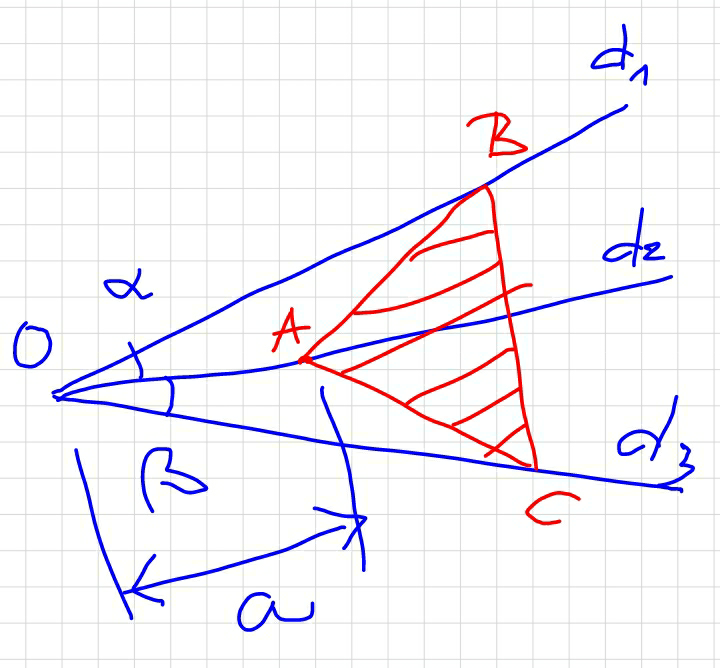
Commented by mrW1 last updated on 20/Jun/17
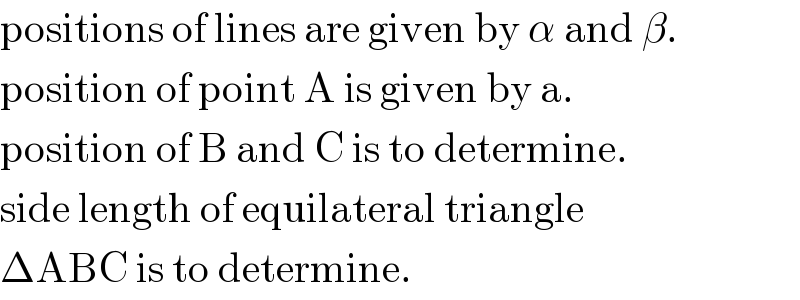
$$\mathrm{positions}\:\mathrm{of}\:\mathrm{lines}\:\mathrm{are}\:\mathrm{given}\:\mathrm{by}\:\alpha\:\mathrm{and}\:\beta. \\ $$$$\mathrm{position}\:\mathrm{of}\:\mathrm{point}\:\mathrm{A}\:\mathrm{is}\:\mathrm{given}\:\mathrm{by}\:\mathrm{a}. \\ $$$$\mathrm{position}\:\mathrm{of}\:\mathrm{B}\:\mathrm{and}\:\mathrm{C}\:\mathrm{is}\:\mathrm{to}\:\mathrm{determine}. \\ $$$$\mathrm{side}\:\mathrm{length}\:\mathrm{of}\:\mathrm{equilateral}\:\mathrm{triangle} \\ $$$$\Delta\mathrm{ABC}\:\mathrm{is}\:\mathrm{to}\:\mathrm{determine}. \\ $$
Commented by b.e.h.i.8.3.4.1.7@gmail.com last updated on 20/Jun/17
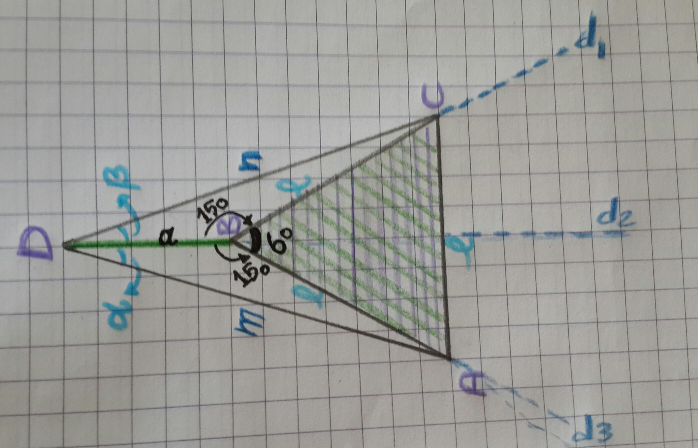
Commented by b.e.h.i.8.3.4.1.7@gmail.com last updated on 20/Jun/17
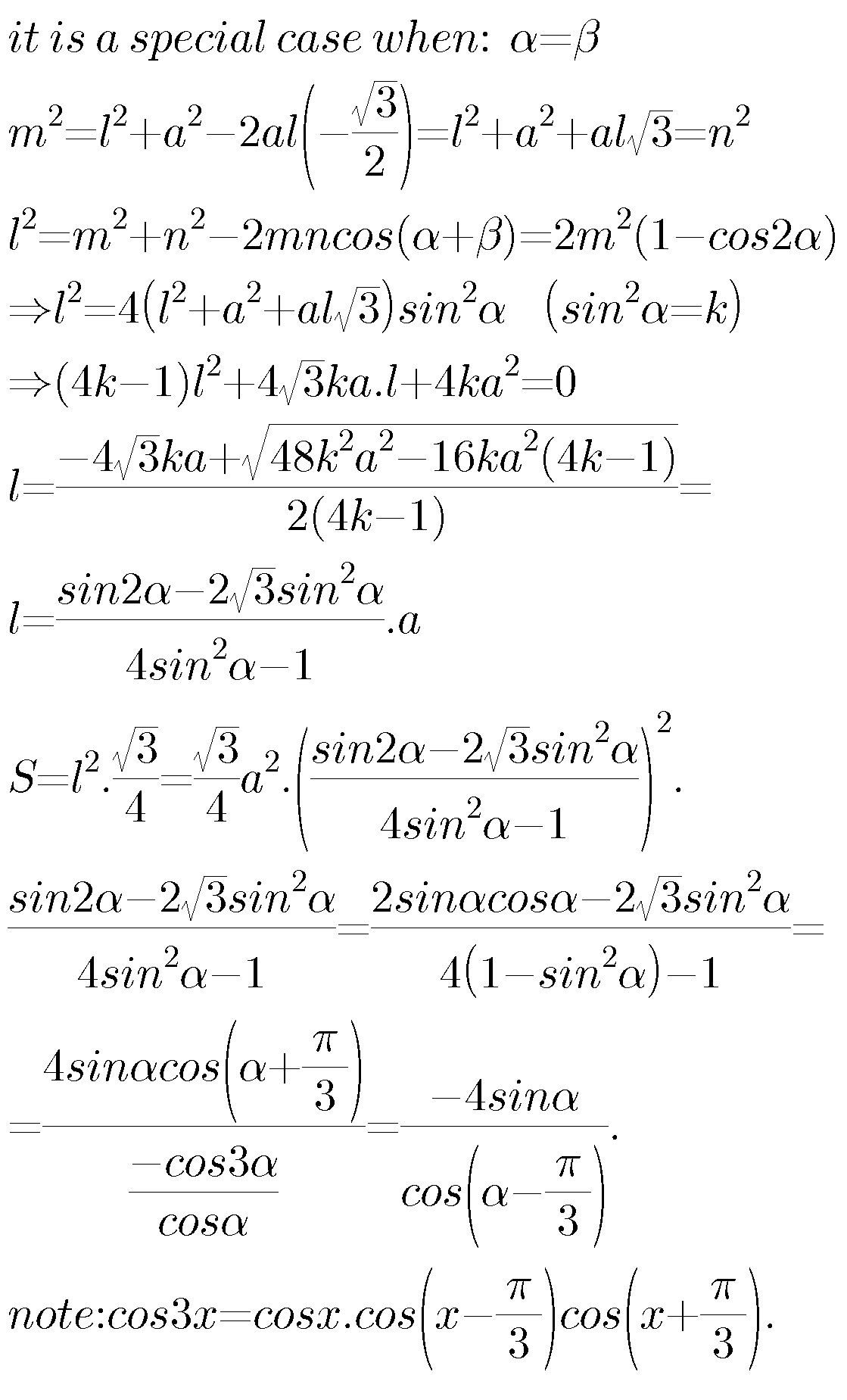
Answered by ajfour last updated on 21/Jun/17
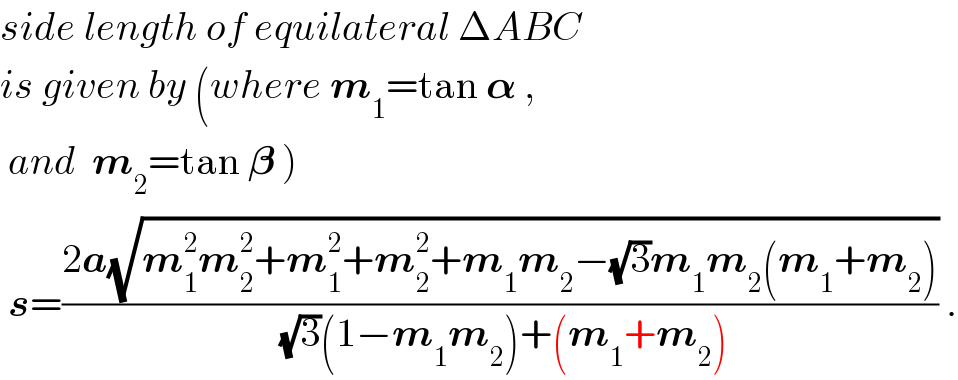
$${side}\:{length}\:{of}\:{equilateral}\:\Delta{ABC} \\ $$$${is}\:{given}\:{by}\:\left({where}\:\boldsymbol{{m}}_{\mathrm{1}} =\mathrm{tan}\:\boldsymbol{\alpha}\:,\right. \\ $$$$\left.\:{and}\:\:\boldsymbol{{m}}_{\mathrm{2}} =\mathrm{tan}\:\boldsymbol{\beta}\:\right) \\ $$$$\:\boldsymbol{{s}}=\frac{\mathrm{2}\boldsymbol{{a}}\sqrt{\boldsymbol{{m}}_{\mathrm{1}} ^{\mathrm{2}} \boldsymbol{{m}}_{\mathrm{2}} ^{\mathrm{2}} +\boldsymbol{{m}}_{\mathrm{1}} ^{\mathrm{2}} +\boldsymbol{{m}}_{\mathrm{2}} ^{\mathrm{2}} +\boldsymbol{{m}}_{\mathrm{1}} \boldsymbol{{m}}_{\mathrm{2}} −\sqrt{\mathrm{3}}\boldsymbol{{m}}_{\mathrm{1}} \boldsymbol{{m}}_{\mathrm{2}} \left(\boldsymbol{{m}}_{\mathrm{1}} +\boldsymbol{{m}}_{\mathrm{2}} \right)}}{\sqrt{\mathrm{3}}\left(\mathrm{1}−\boldsymbol{{m}}_{\mathrm{1}} \boldsymbol{{m}}_{\mathrm{2}} \right)+\left(\boldsymbol{{m}}_{\mathrm{1}} +\boldsymbol{{m}}_{\mathrm{2}} \right)}\:. \\ $$
Commented by ajfour last updated on 20/Jun/17

Commented by ajfour last updated on 20/Jun/17
![A is taken on the right. ∠OAB =θ , ∠OAC = π/3−θ tan α = ((s sin θ)/(a−s cos θ)) = m_1 ...(i) tan β = ((s sin (π/3−θ))/(a−s cos (π/3−θ))) = m_2 ...(ii) from (i): s sin θ=am_1 −sm_1 cos θ s=((am_1 )/(sin θ+m_1 cos θ)) ...=(iii) from (ii): s=((am_2 )/(sin (π/3−θ)+m_2 cos (π/3−θ))) ....(iv) we shall find s from (iii) when we find 𝛉 . And to find 𝛉 we shall equate (iii) and (iv) : m_1 [sin (π/3−θ)+m_2 cos (π/3−θ)] =m_2 [sin θ+m_1 cos θ] m_1 [((√3)/2)cos θ−((sin θ)/2)]+m_1 m_2 [((cos θ)/2)+(((√3)sin θ)/2)] =m_2 sin θ+m_1 m_2 cos θ (cos θ)[(((√3)m_1 )/2) − ((m_1 m_2 )/2)]= (sin θ)[(m_1 /2)−((m_1 m_2 (√3))/2)+m_2 ] ((sin θ)/(cos θ))=((m_1 ((√3)−m_2 ))/(m_1 +2m_2 −(√3)m_1 m_2 )) = (p/b) From (iii) s=((am_1 )/(sin 𝛉+m_1 cos 𝛉)) = ((am_1 (√(p^2 +b^2 )))/(p+m_1 b)) =((am_1 (√(p^2 +b^2 )))/(m_1 ((√3)−m_2 )+m_1 (m_1 +2m_2 −(√3)m_1 m_2 ))) =((a (√(p^2 +b^2 )))/((√3)(1−m_1 m_2 )+(m_1 +m_2 ))) (√(p^2 +b^2 )) comes out to be =2(√((m_1 ^2 m_2 ^2 +m_1 ^2 +m_2 ^2 +m_1 m_2 −(√3)m_1 m_2 (m_1 +m_2 ))) s =((2a(√(m_1 ^2 m_2 ^2 +m_1 ^2 +m_2 ^2 +m_1 m_2 −(√3)m_1 m_2 (m_1 +m_2 ))))/((√3)(1−m_1 m_2 )+(m_1 +m_2 ))) To locate B and C we need only to draw AB and AC at angles 𝛉 and (𝛑/3−𝛉 ) with AO respectively from point A. Then we join BC. 𝛉=tan^(−1) (((m_1 ((√3)−m_2 ))/(m_1 +2m_2 −(√3)m_1 m_2 ))) The ΔABC is now in place and equilateral .](Q16324.png)
$${A}\:{is}\:{taken}\:{on}\:{the}\:{right}. \\ $$$$\:\angle{OAB}\:=\theta\:,\:\angle{OAC}\:=\:\pi/\mathrm{3}−\theta \\ $$$$\:\:\mathrm{tan}\:\alpha\:=\:\frac{{s}\:\mathrm{sin}\:\theta}{{a}−{s}\:\mathrm{cos}\:\theta}\:\:=\:{m}_{\mathrm{1}} \:\:\:\:...\left({i}\right) \\ $$$$\:\:\mathrm{tan}\:\beta\:=\:\frac{{s}\:\mathrm{sin}\:\left(\pi/\mathrm{3}−\theta\right)}{{a}−{s}\:\mathrm{cos}\:\left(\pi/\mathrm{3}−\theta\right)}\:=\:{m}_{\mathrm{2}} \\ $$$$\:\:\:\:\:\:\:\:\:\:\:\:\:\:\:\:\:\:\:\:\:\:\:\:\:\:\:\:\:\:\:\:\:\:\:\:\:\:\:\:\:\:\:\:\:\:\:\:\:\:\:\:\:\:\:\:...\left({ii}\right) \\ $$$${from}\:\left({i}\right): \\ $$$$\:\:{s}\:\mathrm{sin}\:\theta={am}_{\mathrm{1}} −{sm}_{\mathrm{1}} \mathrm{cos}\:\theta \\ $$$$\:\:{s}=\frac{{am}_{\mathrm{1}} }{\mathrm{sin}\:\theta+{m}_{\mathrm{1}} \mathrm{cos}\:\theta}\:\:\:\:\:\:...=\left({iii}\right) \\ $$$$\:\:{from}\:\left({ii}\right): \\ $$$$\:\:{s}=\frac{{am}_{\mathrm{2}} }{\mathrm{sin}\:\left(\pi/\mathrm{3}−\theta\right)+{m}_{\mathrm{2}} \mathrm{cos}\:\left(\pi/\mathrm{3}−\theta\right)} \\ $$$$\:\:\:\:\:\:\:\:\:\:\:\:\:\:\:\:\:\:\:\:\:\:\:\:\:\:\:\:\:\:\:\:\:\:\:\:\:\:\:\:\:\:\:\:\:\:\:\:\:....\left({iv}\right) \\ $$$${we}\:{shall}\:{find}\:\boldsymbol{{s}}\:{from}\:\left({iii}\right)\:{when} \\ $$$${we}\:{find}\:\boldsymbol{\theta}\:.\:{And}\:{to}\:{find}\:\boldsymbol{\theta}\:{we}\:{shall} \\ $$$$\:{equate}\:\left({iii}\right)\:{and}\:\left({iv}\right)\:: \\ $$$${m}_{\mathrm{1}} \left[\mathrm{sin}\:\left(\pi/\mathrm{3}−\theta\right)+{m}_{\mathrm{2}} \mathrm{cos}\:\left(\pi/\mathrm{3}−\theta\right)\right] \\ $$$$\:\:\:\:\:\:\:\:\:\:\:\:\:\:\:\:\:\:\:\:={m}_{\mathrm{2}} \left[\mathrm{sin}\:\theta+{m}_{\mathrm{1}} \mathrm{cos}\:\theta\right] \\ $$$${m}_{\mathrm{1}} \left[\frac{\sqrt{\mathrm{3}}}{\mathrm{2}}\mathrm{cos}\:\theta−\frac{\mathrm{sin}\:\theta}{\mathrm{2}}\right]+{m}_{\mathrm{1}} {m}_{\mathrm{2}} \left[\frac{\mathrm{cos}\:\theta}{\mathrm{2}}+\frac{\sqrt{\mathrm{3}}\mathrm{sin}\:\theta}{\mathrm{2}}\right] \\ $$$$\:\:\:\:\:\:\:\:\:\:\:\:\:\:\:\:\:\:\:={m}_{\mathrm{2}} \mathrm{sin}\:\theta+{m}_{\mathrm{1}} {m}_{\mathrm{2}} \mathrm{cos}\:\theta \\ $$$$\left(\mathrm{cos}\:\theta\right)\left[\frac{\sqrt{\mathrm{3}}{m}_{\mathrm{1}} }{\mathrm{2}}\:−\:\frac{{m}_{\mathrm{1}} {m}_{\mathrm{2}} }{\mathrm{2}}\right]= \\ $$$$\:\:\:\:\:\:\:\:\:\left(\mathrm{sin}\:\theta\right)\left[\frac{{m}_{\mathrm{1}} }{\mathrm{2}}−\frac{{m}_{\mathrm{1}} {m}_{\mathrm{2}} \sqrt{\mathrm{3}}}{\mathrm{2}}+{m}_{\mathrm{2}} \right] \\ $$$$\frac{\mathrm{sin}\:\theta}{\mathrm{cos}\:\theta}=\frac{{m}_{\mathrm{1}} \left(\sqrt{\mathrm{3}}−{m}_{\mathrm{2}} \right)}{{m}_{\mathrm{1}} +\mathrm{2}{m}_{\mathrm{2}} −\sqrt{\mathrm{3}}{m}_{\mathrm{1}} {m}_{\mathrm{2}} }\:=\:\frac{\boldsymbol{{p}}}{\boldsymbol{{b}}} \\ $$$${From}\:\left({iii}\right) \\ $$$$\:\:\boldsymbol{{s}}=\frac{\boldsymbol{{am}}_{\mathrm{1}} }{\mathrm{sin}\:\boldsymbol{\theta}+\boldsymbol{{m}}_{\mathrm{1}} \mathrm{cos}\:\boldsymbol{\theta}} \\ $$$$\:\:\:\:=\:\frac{\boldsymbol{{am}}_{\mathrm{1}} \sqrt{\boldsymbol{{p}}^{\mathrm{2}} +\boldsymbol{{b}}^{\mathrm{2}} }}{\boldsymbol{{p}}+\boldsymbol{{m}}_{\mathrm{1}} \boldsymbol{{b}}} \\ $$$$\:\:\:=\frac{\boldsymbol{{am}}_{\mathrm{1}} \sqrt{\boldsymbol{{p}}^{\mathrm{2}} +\boldsymbol{{b}}^{\mathrm{2}} }}{\boldsymbol{{m}}_{\mathrm{1}} \left(\sqrt{\mathrm{3}}−\boldsymbol{{m}}_{\mathrm{2}} \right)+\boldsymbol{{m}}_{\mathrm{1}} \left(\boldsymbol{{m}}_{\mathrm{1}} +\mathrm{2}\boldsymbol{{m}}_{\mathrm{2}} −\sqrt{\mathrm{3}}\boldsymbol{{m}}_{\mathrm{1}} \boldsymbol{{m}}_{\mathrm{2}} \right)} \\ $$$$=\frac{{a}\:\sqrt{{p}^{\mathrm{2}} +{b}^{\mathrm{2}} }}{\sqrt{\mathrm{3}}\left(\mathrm{1}−{m}_{\mathrm{1}} {m}_{\mathrm{2}} \right)+\left({m}_{\mathrm{1}} +{m}_{\mathrm{2}} \right)} \\ $$$$\:\sqrt{\boldsymbol{{p}}^{\mathrm{2}} +\boldsymbol{{b}}^{\mathrm{2}} }\:{comes}\:{out}\:{to}\:{be} \\ $$$$ \\ $$$$\:\:\:\:\:\:=\mathrm{2}\sqrt{\left({m}_{\mathrm{1}} ^{\mathrm{2}} {m}_{\mathrm{2}} ^{\mathrm{2}} +{m}_{\mathrm{1}} ^{\mathrm{2}} +{m}_{\mathrm{2}} ^{\mathrm{2}} +{m}_{\mathrm{1}} {m}_{\mathrm{2}} −\sqrt{\mathrm{3}}{m}_{\mathrm{1}} {m}_{\mathrm{2}} \left({m}_{\mathrm{1}} +{m}_{\mathrm{2}} \right)\right.}\: \\ $$$$ \\ $$$$\:\boldsymbol{{s}}\:=\frac{\mathrm{2}\boldsymbol{{a}}\sqrt{\boldsymbol{{m}}_{\mathrm{1}} ^{\mathrm{2}} \boldsymbol{{m}}_{\mathrm{2}} ^{\mathrm{2}} +\boldsymbol{{m}}_{\mathrm{1}} ^{\mathrm{2}} +\boldsymbol{{m}}_{\mathrm{2}} ^{\mathrm{2}} +\boldsymbol{{m}}_{\mathrm{1}} \boldsymbol{{m}}_{\mathrm{2}} −\sqrt{\mathrm{3}}\boldsymbol{{m}}_{\mathrm{1}} \boldsymbol{{m}}_{\mathrm{2}} \left(\boldsymbol{{m}}_{\mathrm{1}} +\boldsymbol{{m}}_{\mathrm{2}} \right)}}{\sqrt{\mathrm{3}}\left(\mathrm{1}−\boldsymbol{{m}}_{\mathrm{1}} \boldsymbol{{m}}_{\mathrm{2}} \right)+\left(\boldsymbol{{m}}_{\mathrm{1}} +\boldsymbol{{m}}_{\mathrm{2}} \right)} \\ $$$$\boldsymbol{{T}}{o}\:{locate}\:{B}\:{and}\:{C}\:{we}\:{need}\:{only} \\ $$$${to}\:{draw}\:{AB}\:{and}\:{AC}\:{at}\:{angles} \\ $$$$\:\boldsymbol{\theta}\:{and}\:\left(\boldsymbol{\pi}/\mathrm{3}−\boldsymbol{\theta}\:\right)\:{with}\:{AO}\:{respectively} \\ $$$${from}\:{point}\:{A}.\:{Then}\:{we}\:{join}\:{BC}. \\ $$$$\:\boldsymbol{\theta}=\mathrm{tan}^{−\mathrm{1}} \left(\frac{\boldsymbol{{m}}_{\mathrm{1}} \left(\sqrt{\mathrm{3}}−\boldsymbol{{m}}_{\mathrm{2}} \right)}{\boldsymbol{{m}}_{\mathrm{1}} +\mathrm{2}\boldsymbol{{m}}_{\mathrm{2}} −\sqrt{\mathrm{3}}\boldsymbol{{m}}_{\mathrm{1}} \boldsymbol{{m}}_{\mathrm{2}} }\right) \\ $$$$\boldsymbol{{T}}{he}\:\Delta{ABC}\:{is}\:{now}\:{in}\:{place}\:{and} \\ $$$$\:{equilateral}\:. \\ $$$$\: \\ $$
Commented by ajfour last updated on 20/Jun/17
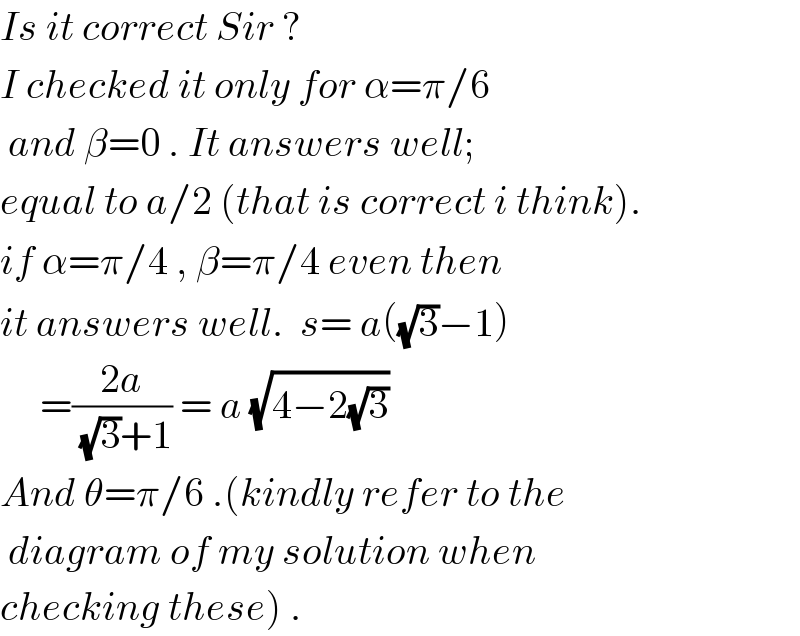
$${Is}\:{it}\:{correct}\:{Sir}\:? \\ $$$${I}\:{checked}\:{it}\:{only}\:{for}\:\alpha=\pi/\mathrm{6} \\ $$$$\:{and}\:\beta=\mathrm{0}\:.\:{It}\:{answers}\:{well};\: \\ $$$${equal}\:{to}\:{a}/\mathrm{2}\:\left({that}\:{is}\:{correct}\:{i}\:{think}\right). \\ $$$${if}\:\alpha=\pi/\mathrm{4}\:,\:\beta=\pi/\mathrm{4}\:{even}\:{then} \\ $$$${it}\:{answers}\:{well}.\:\:{s}=\:{a}\left(\sqrt{\mathrm{3}}−\mathrm{1}\right) \\ $$$$\:\:\:\:\:=\frac{\mathrm{2}{a}}{\sqrt{\mathrm{3}}+\mathrm{1}}\:=\:{a}\:\sqrt{\mathrm{4}−\mathrm{2}\sqrt{\mathrm{3}}}\:\: \\ $$$${And}\:\theta=\pi/\mathrm{6}\:.\left({kindly}\:{refer}\:{to}\:{the}\right. \\ $$$$\:{diagram}\:{of}\:{my}\:{solution}\:{when} \\ $$$$\left.{checking}\:{these}\right)\:. \\ $$
Commented by mrW1 last updated on 20/Jun/17
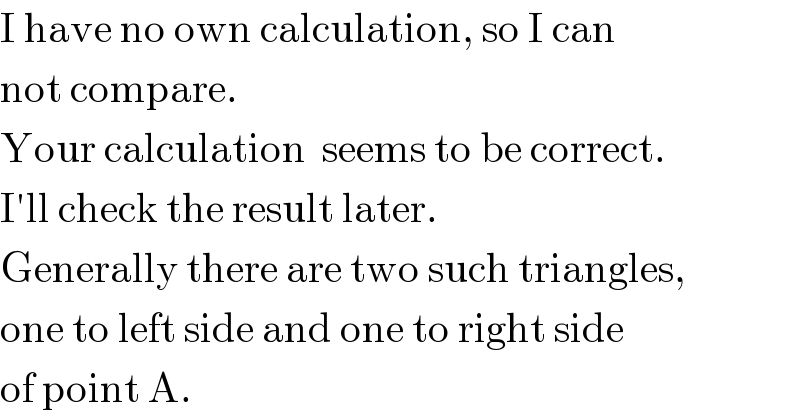
$$\mathrm{I}\:\mathrm{have}\:\mathrm{no}\:\mathrm{own}\:\mathrm{calculation},\:\mathrm{so}\:\mathrm{I}\:\mathrm{can} \\ $$$$\mathrm{not}\:\mathrm{compare}. \\ $$$$\mathrm{Your}\:\mathrm{calculation}\:\:\mathrm{seems}\:\mathrm{to}\:\mathrm{be}\:\mathrm{correct}. \\ $$$$\mathrm{I}'\mathrm{ll}\:\mathrm{check}\:\mathrm{the}\:\mathrm{result}\:\mathrm{later}. \\ $$$$\mathrm{Generally}\:\mathrm{there}\:\mathrm{are}\:\mathrm{two}\:\mathrm{such}\:\mathrm{triangles}, \\ $$$$\mathrm{one}\:\mathrm{to}\:\mathrm{left}\:\mathrm{side}\:\mathrm{and}\:\mathrm{one}\:\mathrm{to}\:\mathrm{right}\:\mathrm{side} \\ $$$$\mathrm{of}\:\mathrm{point}\:\mathrm{A}. \\ $$
Commented by mrW1 last updated on 21/Jun/17

$$\mathrm{Following}\:\mathrm{picture}\:\mathrm{shows}\:\mathrm{how}\:\mathrm{to} \\ $$$$\mathrm{draw}\:\mathrm{the}\:\mathrm{requested}\:\mathrm{triangles}\:\mathrm{only} \\ $$$$\mathrm{with}\:\mathrm{ruler}\:\mathrm{and}\:\mathrm{compass}. \\ $$
Commented by mrW1 last updated on 20/Jun/17
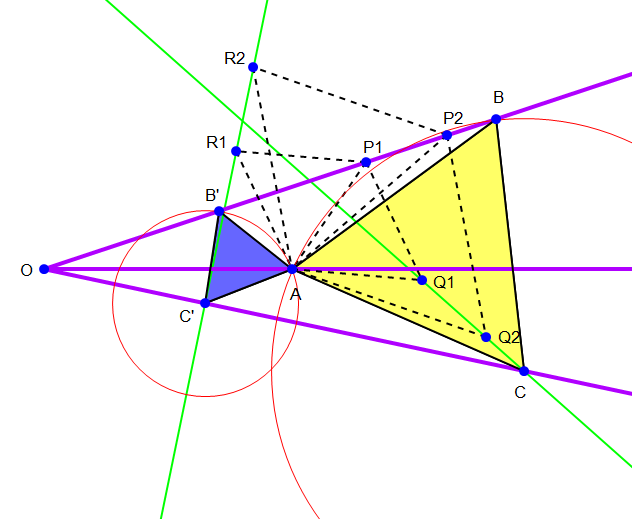
Commented by ajfour last updated on 20/Jun/17

$${tbank}\:{you}\:{Sir}. \\ $$
Commented by mrW1 last updated on 21/Jun/17

$$\mathrm{How}\:\mathrm{does}\:\mathrm{your}\:\mathrm{formula}\:\mathrm{change}\:\mathrm{for} \\ $$$$\mathrm{the}\:\mathrm{triangle}\:\mathrm{on}\:\mathrm{the}\:\mathrm{richt}\:\mathrm{side}\:\mathrm{of}\:\mathrm{point} \\ $$$$\mathrm{A}? \\ $$
Commented by ajfour last updated on 21/Jun/17
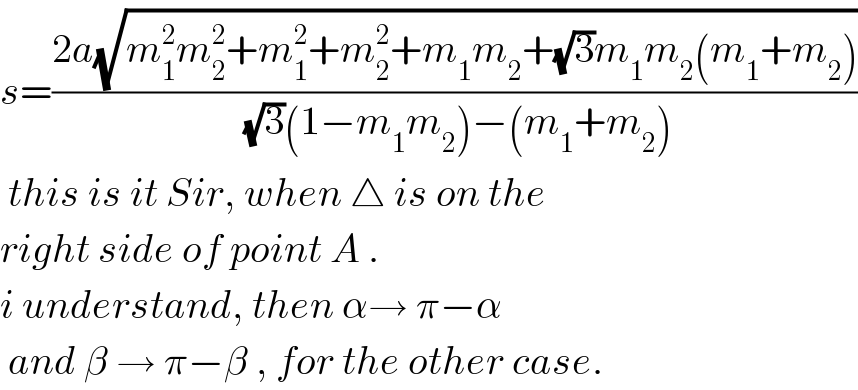
$${s}=\frac{\mathrm{2}{a}\sqrt{{m}_{\mathrm{1}} ^{\mathrm{2}} {m}_{\mathrm{2}} ^{\mathrm{2}} +{m}_{\mathrm{1}} ^{\mathrm{2}} +{m}_{\mathrm{2}} ^{\mathrm{2}} +{m}_{\mathrm{1}} {m}_{\mathrm{2}} +\sqrt{\mathrm{3}}{m}_{\mathrm{1}} {m}_{\mathrm{2}} \left({m}_{\mathrm{1}} +{m}_{\mathrm{2}} \right)}}{\sqrt{\mathrm{3}}\left(\mathrm{1}−{m}_{\mathrm{1}} {m}_{\mathrm{2}} \right)−\left({m}_{\mathrm{1}} +{m}_{\mathrm{2}} \right)} \\ $$$$\:{this}\:{is}\:{it}\:{Sir},\:{when}\:\bigtriangleup\:{is}\:{on}\:{the} \\ $$$${right}\:{side}\:{of}\:{point}\:{A}\:. \\ $$$${i}\:{understand},\:{then}\:\alpha\rightarrow\:\pi−\alpha \\ $$$$\:{and}\:\beta\:\rightarrow\:\pi−\beta\:,\:{for}\:{the}\:{other}\:{case}. \\ $$
Commented by mrW1 last updated on 21/Jun/17

$$\mathrm{absolutely}\:\mathrm{smart}\:\mathrm{work}! \\ $$
